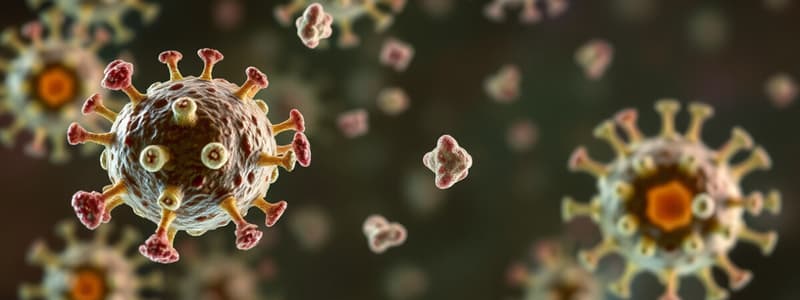Podcast
Questions and Answers
Considering the multifaceted transition from innate to adaptive immunity, which of the following mechanisms most accurately describes how the complement system facilitates this transition?
Considering the multifaceted transition from innate to adaptive immunity, which of the following mechanisms most accurately describes how the complement system facilitates this transition?
- Through its exclusive reliance on the classical pathway activated by antibodies, thereby bypassing innate recognition mechanisms.
- Via its capacity for activation through both innate (PRRs recognizing PAMPs) and adaptive (antibody-mediated) pathways, generating inflammatory cytokines that recruit and activate T cells, thereby bridging both immune arms. (correct)
- By exclusively activating the alternative pathway independently of antibody involvement, thus ensuring a purely innate response.
- By directly inducing B cell proliferation and antibody production without the need for T cell involvement or antigen presentation.
In the context of inflammation as a bridge between innate and adaptive immunity, which statement most accurately describes the role of pattern recognition receptors (PRRs) and pathogen-associated molecular patterns (PAMPs)?
In the context of inflammation as a bridge between innate and adaptive immunity, which statement most accurately describes the role of pattern recognition receptors (PRRs) and pathogen-associated molecular patterns (PAMPs)?
- PRRs recognize a broad range of self-antigens, initiating autoimmunity which then cross-activates adaptive immunity against pathogens.
- PRR-PAMP interactions are solely responsible for suppressing inflammation to prevent damage to host tissues, thereby preventing initiation of adaptive immunity.
- The interaction of PRRs and PAMPs focuses the innate immune system on antigens indicative of infection, initiating inflammation that subsequently directs adaptive immune cells to the infection site. (correct)
- PRR-PAMP interactions facilitate the recognition of highly specific antigenic determinants, enabling a precise adaptive immune response without inflammation.
Given the role of cytokines in modulating immune responses, which of the following scenarios best illustrates the complex interplay between cytokine signaling and the transition from innate to adaptive immunity?
Given the role of cytokines in modulating immune responses, which of the following scenarios best illustrates the complex interplay between cytokine signaling and the transition from innate to adaptive immunity?
- The secretion of TNF-alpha exclusively by neutrophils, directly activating B cells to produce high-affinity antibodies without T cell help.
- The exclusive secretion of IL-10 by macrophages, leading to the suppression of T cell activation and prevention of autoimmunity.
- The secretion of TGF-β by regulatory T cells, directly inhibiting the phagocytic activity of macrophages and thereby preventing inflammation.
- The coordinated release of IL-12 by dendritic cells stimulating IFN-γ production by NK cells, which in turn enhances antigen presentation by APCs to T cells, thus bridging innate and adaptive immunity. (correct)
Considering the differences in antigen recognition between innate and adaptive immunity, which statement best describes the fundamental distinction in their recognition mechanisms?
Considering the differences in antigen recognition between innate and adaptive immunity, which statement best describes the fundamental distinction in their recognition mechanisms?
How does the migration and antigen presentation by antigen-presenting cells (APCs) like dendritic cells facilitate the transition from innate to adaptive immunity in the context of a peripheral tissue infection?
How does the migration and antigen presentation by antigen-presenting cells (APCs) like dendritic cells facilitate the transition from innate to adaptive immunity in the context of a peripheral tissue infection?
Considering scenarios where the innate immune response is insufficient to clear an infection, what immunological process is most critical for initiating a coordinated adaptive immune response?
Considering scenarios where the innate immune response is insufficient to clear an infection, what immunological process is most critical for initiating a coordinated adaptive immune response?
In the context of adaptive immunity improving over time and reducing infection severity upon re-infection, what immunological mechanism best explains this phenomenon?
In the context of adaptive immunity improving over time and reducing infection severity upon re-infection, what immunological mechanism best explains this phenomenon?
How does opsonization, resulting from complement activation or antibody binding, enhance the transition from innate to adaptive immunity?
How does opsonization, resulting from complement activation or antibody binding, enhance the transition from innate to adaptive immunity?
Given that the transition from innate to adaptive immunity is not a single event, but rather a multifaceted process, which of the following examples best illustrates the convergence of multiple 'vehicles' in driving this transition?
Given that the transition from innate to adaptive immunity is not a single event, but rather a multifaceted process, which of the following examples best illustrates the convergence of multiple 'vehicles' in driving this transition?
In what manner do activated B cells and plasma cells contribute to the resolution phase of an infection, and how does this link back to the initial innate immune response?
In what manner do activated B cells and plasma cells contribute to the resolution phase of an infection, and how does this link back to the initial innate immune response?
Flashcards
Cytokines
Cytokines
Small signaling proteins released by immune cells that regulate and coordinate immune responses.
Inflammation
Inflammation
The body's ability to recognize and destroy invading microbes, leading to resolution or healing.
PAMPs
PAMPs
Molecules present on pathogens that are recognized by the innate immune system.
The Complement System
The Complement System
Signup and view all the flashcards
Antigen-Presenting Cells (APCs)
Antigen-Presenting Cells (APCs)
Signup and view all the flashcards
Cell-Mediated Immunity
Cell-Mediated Immunity
Signup and view all the flashcards
Humoral Immunity
Humoral Immunity
Signup and view all the flashcards
Antibodies
Antibodies
Signup and view all the flashcards
Opsonization
Opsonization
Signup and view all the flashcards
Study Notes
- Cytokines are small signaling proteins released by immune cells that regulate and coordinate immune responses.
- Cytokines can recruit additional immune cells to the site of infection or inflammation, signaling to other immune cells.
- Cytokines alter the behavior and physiology of target cells, such as increasing antigen presentation by APCs or activating T and B cells.
- Cytokines direct adaptive immune cells like T cells and B cells to infection sites, ensuring the immune response becomes more specific, bridging innate and adaptive immunity.
- Innate immunity protects all multicellular organisms from microbes that can lead to infection.
- In many instances, the innate immune response can defeat infections without adaptive immunity.
- When innate immunity is not sufficient, the inflammatory process generates a more coordinated attack by utilizing adaptive immunity.
- Inflammation bridges innate to adaptive immunity.
- PRRs and PAMPs interactions focus the Innate System on antigens that can cause infection.
- Antibodies, B cells, and T cells recognize finer details of molecular structure and can attack pathogens with specificity.
- The transition from innate to adaptive immunity employs multiple vehicles heading in the same direction, but may take different routes to arrive to the same outcome.
- These multiple vehicles are navigating within inflammation, which is the body's ability to recognize and destroy invading microbes until resolution or healing is achieved.
- The complement system straddles the innate and adaptive immune system.
- Activation of the complement system can occur by immune cells recognizing PAMPs or by antibodies (classical pathway).
- Opsonization and lysis via complement produce inflammatory cytokines, recruiting T cells to the site of infection and possibly initiating cell mediated and humoral immunity.
- Antigen presenting cells (APCs) such as macrophages and dendritic cells migrate to the site of infection to internalize and process antigens.
- As APCs mature, antigen is presented to circulating T cells.
- Reactivation of T cells can lead to cell mediated immunity, humoral immunity, and B cell activation.
- Invading microbes are destroyed by phagocytosis, opsonization, or cytotoxicity.
- Cytokines modify the behavior and physiology of target cells and tissues.
- Cytokine secretion supports the inflammatory response and directs traffic from innate to adaptive immunity.
- Adaptive immunity is employed by activated B cells and plasma cells in the development of highly specific antibodies.
- Adaptive immune response will improve over time and significantly reduce infection time and severity upon reinfection.
- If the innate immune system can slow pathogen growth, it allows extra treatment for the adaptive immune system to respond and control or eliminate a foreign pathogen.
- The innate immune system sends a signal to the adaptive immune system, guiding them how to attack the pathogen.
- Dendritic cells have pattern recognition receptors, and they move and bring those antigens and the specific details about the antigen to the exact immune system.
Studying That Suits You
Use AI to generate personalized quizzes and flashcards to suit your learning preferences.




